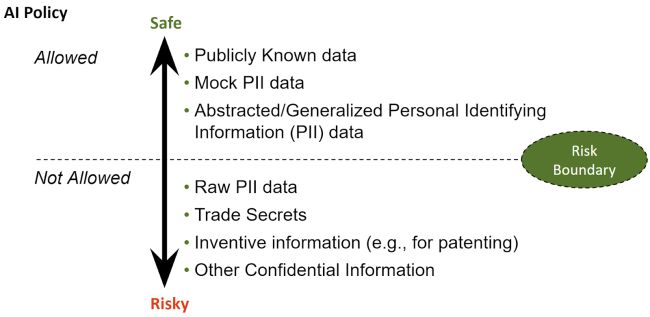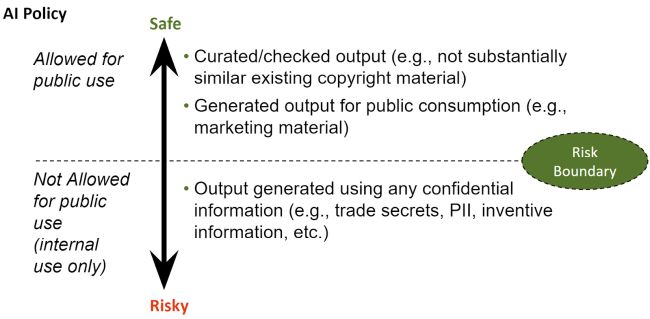PatentNext Takeaway: Companies have increased access to artificial intelligence (AI) tools, such as ChatGPT and Github Copilot, which promise to improve the efficiency and work product output of employees. However, the adoption of such AI tools is not without risks, including the risk of loss of intellectual property (IP) rights. Accordingly, companies should proceed with caution by considering developing an AI policy to help eliminate or mitigate such risks. An AI policy can look similar to, and in many cases be a supplement to, a company's open-source software policy.
****
A company onboarding artificial intelligence (AI) tools can experience increased efficiencies of work product output by employees, including the acceleration of software and source code development.
However, there are several intellectual property (IP) risks that should be considered when onboarding such AI tools. This article explores certain IP-related risks of adopting and using AI tools and also provides AI policy considerations and example strategies for how to eliminate or mitigate such risks.
Potential Risks
Risk 1: Possible Loss of Patent or Trade Secret Rights
Under U.S. Patent law, public disclosure of inventive information can destroy potential patent rights. That is, a claimed invention can be found invalid if it is made "available to the public" (e.g., a public disclosure) more than 1 year before the effective filing date of the claimed invention. See 35 U.S.C. § 102.
Similarly, a public disclosure can eliminate a trade secret. To be legally considered a trade secret in the United States, a company must make a reasonable effort to conceal the information from the public.
With respect to AI tools, a user's input into a generative AI tool, such as ChatGPT or Github Copilot, may be considered a "public disclosure" that could destroy patent and/or trade secret rights. For example, OpenAI (the creator of ChatGPT) provides in its "Terms of Use" that a user's input may be reviewed or used by OpenAI "to help develop and improve [their] Services."
Thus, the input of sensitive data (e.g., patent claims, trade secret data) in ChatGPT's prompt could be considered to be a "public disclosure" that, if significant, could result in waiving trade secret protection and/or precluding patent protection.
Risk 2: Unintended Data Sharing
Data provided to an AI tool can be used in unintended ways. For example, a company's provision of sensitive information (e.g., patent claims, trade secret information, source code, or the like) to a third party (e.g., OpenAI) via an AI tool (e.g., ChatGPT) could result in such sensitive information being used to train and/or update the AI model. Furthermore, in an unlikely but possible scenario, a newly trained model (e.g., as trained with a company's data) may then output sensitive data (e.g., confidential information) to third parties (e.g., competitors).
Thus, through the mere use of an AI tool, a company could unintentionally provide sensitive information to others, including its competitors.
Risk 3: Potential Issues with Copyright Authorship / Patent Inventorship
Ownership of a copyrighted work (e.g., source code) begins with authorship, where an author is a person who fixed the work in a tangible medium of expression. See 17 U.S.C. § 102(a). For example, for software, this can include simply saving the source code in computer memory. Under current U.S. laws, an AI system or tool cannot be an "author"; only a human can be. See, e.g., PatentNext: U.S. Copyright Office Partially Allows Registration of Work having AI-generated Images ("Zarya of the Dawn").
Similarly, patent rights begin with inventorship, where an inventor is a person who conceives of at least one element of a claim element of a patent. Under current U.S. laws, an AI system or tool cannot be an "inventor"; only a human can be. See PatentNext: Can an Artificial Intelligence (AI) be an Inventor?
Thus, if an AI system or tool cannot be an "author" or an "inventor," as those terms are interpreted according to U.S. law, then what happens when a "generative" AI model (e.g., ChatGPT) produces new content, e.g., text, images, or inventive ideas, in the form of an answer or other output (e.g., a picture) it provides in response to a user's input?
The question underscores a potential risk to valuable copyrights and/or patent rights by the use of an AI system or tool to generate new seemingly copyrighted works (e.g., source code) and/or conceive of seemingly patentable inventions. Currently, the U.S. copyright office requires authors to disclose whether AI was used in creating a given work; the copyright office will not allow registration or protection of AI-generated works. See, e.g., PatentNext: How U.S. Copyright Law on Artificial Intelligence (AI) Authorship Has Gone the Way of the Monkey.
The U.S. Patent Office has yet to address this issue with respect to inventorship; thus, a patent created with the assistance of an AI tool could be called into question, including possibly rendering an AI-generated patent claim invalid, at least according to one school of thought. See PatentNext: Do you have to list an Artificial Intelligence (AI) system as an inventor or joint inventor on a Patent Application?
Risk 4: Inaccurate and Faulty output (AI "hallucinations")
While the output of a generative AI Tool (e.g., ChatGPT or Github Copilot) can be impressive and seem "human" or almost human, it is important to remember that a generative AI tool does not "understand" or otherwise comprehend a question or dialogue in the same sense a human does.
Rather, a generative AI tool (e.g., ChatGPT or Github Copilo) is limited in how it has been trained and seeks to generate an output with a selection and arrangement of words and phrases with the highest probability mathematical output, regardless of any true understanding.
This can lead to an AI "hallucination" (i.e., faulty output), which is a factual mistake in an AI tool's generated text that can seem semantically or syntactically plausible but is, in fact, incorrect or nonsensical. In short, a user can't trust what the machine is explaining or outputting. As Yann LeCun, a well-known pioneer in AI, once observed regarding AI hallucinations: "[l]arge language models [e.g., such as ChatGPT] have no idea of the underlying reality that language describes" and can "generate text that sounds fine, grammatically, semantically, but they don't really have some sort of objective other than just satisfying statistical consistency with the prompt."
One example of an AI hallucination with a real-world impact involved an attorney, Steven Schwartz (licensed in New York). Mr. Schwartz created a legal brief for a case (Mata v. Avianca) in a Federal District Court (S.D.N.Y.) that included fake judicial opinions and legal citations, all generated by ChatGPT. The court could not find the judicial opinions cited in the legal brief and asked Mr. Schwartz to provide them. But he could not do so because such opinions did not exist. ChatGPT simply made them up via AI hallucinations. Later, at a hearing regarding the matter, Mr. Schwartz told the Judge (Judge Castel): "I did not comprehend that ChatGPT could fabricate cases." Judge Castel sanctioned Mr. Schwartz $5,000. Judge Castel also noted that there was nothing "inherently improper" about using artificial intelligence for assisting in legal work, but lawyers have a duty to ensure their filings were accurate. As a result, judges and courts have since issued orders regarding the use of AI tools, where, for example, if an AI tool was used to prepare a legal filing, then (1) such use must be disclosed; (2) an attorney must certify that each and every legal citation has been verified and is accurate.
Risk 5: Bias
A generative AI tool can be limited by its reliance on the human operators (and their potential and respective biases) that trained the AI tool in the first place. That is, during a supervised learning phase of training, an AI tool may not have learned an ideal answer because the specific people selected to train the tool chose specific responses based on what they thought or knew was "right," at least at the time, but where such responses may have been incorrect, or at least not ideal, at the time of training. The risk is that such training can lead to biased output, e.g., not reflective of target user or customer needs and/or sensitivities.
Still further, a different kind of bias can come from "input bias," in which a generative AI tool can respond with inconsistent answers based on minor changes to a user's question. This can include where minor changes to a user's input can, on the one hand, cause a generative AI tool to claim not to know an answer in one instance or, on the other hand, answer correctly in a different instance. This can lead to inconsistent/non-reliable output, e.g., where one user receives one answer, but another user receives a different answer based on similar but different input.
AI Policy Considerations and Mitigation Strategies
The below discussion provides AI policy considerations and example strategies for how to possibly eliminate or mitigate the potential risks described above.
Avoid public disclosures implicit in AI Tools
One possible solution for reducing the risk of public disclosure is to obtain a private instance of a generative AI tool (e.g., ChatGPT). A private instance is a version of the AI tool that could be securely installed on a private network inside a company.
Ideally, the private instance would receive and respond to any queries from employees. Importantly, such queries would not be sent publicly over the Internet or to a third party. This could avoid potential 35 U.S.C. § 102 public disclosures and/or trade secret-destroying disclosures that could occur through the use of standard or freely available tools, such as ChatGPT, available to individual users.
Negotiate or set favorable terms or features that avoid improper data misuse
Typically, acquiring a private instance of an AI tool (e.g., such as ChatGPT) includes negotiating terms and/or setting up features of the AI tool during installation. Favorable terms and/or features can avoid improper data misuse by others and further prevent unwanted public disclosure.
For example, a company can reduce risk by negotiating favorable terms with AI tool providers and/or requiring the setting of the following features with respect to a given AI tool:
- The company should require two-way confidentiality, in which data provided to and sent from the AI tool is secured and treated as confidential by both parties, i.e., the company using the AI tool and the AI tool provider.
- The company should opt out of any data training scheme that allows the AI tool provider to use the company's provided data as training data to update the AI tool.
- The company should require a zero-data retention such that any input provided to the AI tool provider is not stored by the AI tool provider.
- The company should require an indemnity from the use of the AI tool. For example, the AI tool provider should agree to indemnify the user and/or the company against any future infringement claims, e.g., copyright infringement. For example, Microsoft has agreed to indemnify commercial users of its GitHub Copilot tool for generating source code from AI.
Formal AI Policy
The company can prepare a formal AI Policy to be followed by employees. The AI Policy can be similar to, or in addition to (e.g., a supplement to), the company's Open-Source Software policy. For example, the AI Policy can involve:
- Creating a whitelist of allowed AI tools.
- Creating a blacklist of disallowed AI tools.
- Assigning a Single Point of Contact (SPOC) person or team to facilitate questions regarding AI usage.
- Avoiding or minimizing copyright infringement: The company can check that the output of a generative AI tool is sufficiently different from (not substantially similar to) data used to train the AI tool's underlying model (e.g., to reduce potential accusations of copyright infringement of substantially similar works).
- Mitigating Inventorship/Authorship disputes: The company can require authors and/or inventors to keep an input/output log as evidence to show human contributions/conception to copyrightable works and/or patent claim elements.
- Categorizing/ranking Data types based on risk: The AI Policy can categorize or rank which data inputs and/or outputs to allow. This can be based on the type of data and the company's risk tolerance (see below example charts illustrating this).
Categorizing and/or ranking of data types based on a company's risk tolerance can involve defining data types and a risk boundary. Then, the company can determine whether data types are considered "safe" or "risky" based on the risk boundary, which can be the amount of risk the company is willing to accept for the benefit of using of a given AI tool.
The chart below provides an example framework for AI inputs. The below example framework illustrates data types as input into a generative AI tool such as ChatGPT across a given risk boundary defining "allowed" and "not allowed" use cases:

As shown above, data that is publicly known and/or nonconfidential data is allowed as input into a given AI tool (e.g., ChatGPT). On the other hand, confidential information, such as PII, trade secret data, and/or inventive information for patenting, is not.
Similarly, the chart below provides an example framework for AI outputs. The below example framework illustrates data types as output by a generative AI tool such as ChatGPT across a given risk boundary defining "allowed for public use" and "not allowed for public use" use cases:

As shown above, data that is curated, checked, or that is generated specifically for public consumption is allowed as output from a given AI tool (e.g., ChatGPT). On the other hand, confidential data output based on confidential information is not allowed.
Eliminate or reduce low-quality model output and model bias
When training an AI model, a company should consider the risk of model bias (as discussed above). One related risk that should be considered is the programmer's age-old adage of "garbage in, garbage out." This effectively means that inputting garbage data (e.g., erroneous or non-related data) will result in garbage output (e.g., erroneous or non-related output). In the case of AI models, inputting low-quality training data will lead to low-quality model output, which should be avoided. Instead, a company should use curated data that is property correlated in order to make the AI model's output high-quality and accurate.
Also, a company should consider using only licensed or free data for training an AI model. Using such licensed or free data can avoid accusations of copyright infringement, where the company could be accused of improperly using licensed/copyright data to train an AI model.
Finally, an AI model should be trained in a manner to eliminate model bias. This can include using data with sufficient variability/breadth to avoid model bias with respect to end-user needs and/or sensitivities. Model bias can be further reduced by implementing or considering ethical considerations and concerns, such as those put forward by the White House's Blue Blueprint for an AI Bill of Rights, which seeks to acknowledge and address potential inherent ethical and bias-based risks of AI systems. See PatentNext: Ethical Considerations of Artificial Intelligence (AI) and the White House's Blueprint for an AI Bill of Rights.
More recently, President Biden issued an Executive Order on Safe, Secure, and Trustworthy Artificial Intelligence practices. One of the enumerated requirements of the Executive Order requires AI developers to address algorithmic discrimination "through training, technical assistance, and coordination between the Department of Justice and Federal civil rights offices on best practices for investigating and prosecuting civil rights violations related to AI." The goal of the requirement seeks to eliminate bias because, according to the Executive Order, "[i]rresponsible uses of AI can lead to and deepen discrimination, bias, and other abuses in justice, healthcare, and housing."
Another enumerated requirement of the Executive Order states that "developers of the most powerful AI systems share their safety test results and other critical information with the U.S. government." It can be assumed that "most powerful AI systems" refer to AI systems such as ChatGPT, and the "developers" are those companies that develop such AI systems, e.g., OpenAI. Thus, most companies that simply use AI tools (and that do not develop them) will not be affected by this requirement of the Executive Order.
Conclusion
An AI tool, if adopted by a company or other organization, should be considered in view of its potential impacts on IP-related rights. Using an AI tool without an AI Policy to assist the management of important IP considerations could result in the loss of IP-related rights for the company. Therefore, a company should consider developing an AI Policy that eliminates, or at least mitigates, the risk of IP loss from AI tool adoption and/or uncontrolled AI tool use by employees.
The content of this article is intended to provide a general guide to the subject matter. Specialist advice should be sought about your specific circumstances.

